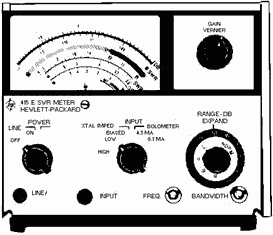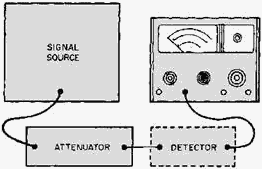Module 21 - Test Methods and Practices |
||||||||||||||||||||||||||||||||||||||||||||||||||
|
Module 21 − Test Methods and Practices
Pages i , 1−1, 1−11, 1−21, 2−1, 2−11, 2−21, 2−31, 2−41, 3−1, 3−11, 3−21, 3−31, 4−1, 4−11, 5−1, 5−11, 5−21, 5−31, AI−1 to AI−3, Index
Attenuation in a coaxial line in terms of decibels per foot can be determined by the following formula:
As a technician, you need not be concerned with designing coaxial transmission lines. It is, however, our feeling that you should be familiar with the parameters that go into making a transmission line. It can readily be seen by the above formulas that transmission lines cannot be randomly selected without consideration of system requirements. NAVSHIPS 0967-000-0140, EIMB, Reference Data, section 3, lists the characteristics of most common transmission lines.
Q-5. What factor has the greatest effect on the physical size of a coaxial cable?
Q-6. Is the attenuation of a coaxial cable independent of frequency?
INTERMODULATION Distortion MEASUREMENTS
Intermodulation distortion occurs when two or more frequencies become mixed across a nonlinear device. The resultants are the difference frequency and the sum frequency, both components of the originals. Undesirable frequencies can be generated by a mixing of two discrete frequencies. Spurious radiation, arising from close spacing of transmitter and receiver, is a prime source of an undesirable frequency that can cause intermodulation distortion in an electronic circuit. This is particularly the case when antenna couplers are employed. Cross modulation and parasitic generation (described in the next section) are two other sources of undesirable frequencies that may cause intermodulation distortion.
Q-7. What is the main cause of intermodulation distortion?
CROSS MODULATION and PARASITIC GENERATION
CROSS MODULATION occurs when a signal from an adjacent channel crosses over into a second channel and modulates the frequency of the second channel. PARASITIC GENERATION occurs when regenerative feedback is sufficient to cause a circuit to oscillate, even though it is not designed to oscillate. Both types of distortion are common to systems that are misaligned.
INTERMODULATION Distortion DETECTION
The presence of intermodulation distortion is determined by a two-tone test method. Two sinusoidal frequencies of equal amplitude are introduced into the system under test. The two frequencies are spaced
4-11 close together with reference to the unit under test. The output of the system under test (an amplifier, receiver, or transmitter) is monitored on a spectrum analyzer that is comparable in characteristics to the suspect system. The resultant display should be an exact reproduction of the input frequencies. If not, some form of intermodulation distortion is present. To determine if external sources are causing the intermodulation distortion, you can use a single-frequency signal. If the display on the spectrum analyzer does not show the single frequency, then intermodulation distortion is present.
Intermodulation distortion cannot be entirely suppressed, but it can be minimized by shielding components and circuitry, parasitic suppression circuitry, and antenna spacing. These factors are incorporated in the design of the system and are tested during production. Any shields or parasitic suppressors that are removed by the technician must be replaced before troubleshooting and/or repair can be effective. Antenna locations also pose a consideration when installing a new system. Ship alteration specifications must be observed when new antenna systems are being installed.
Q-8. When you are testing a piece of equipment for intermodulation distortion, what should the output of the equipment look like?
Summary
The important points of this chapter are summarized in the following paragraphs:
Standing WAVES are the result of an impedance mismatch between a transmission line and its load. If a transmission line is not properly terminated, it will cause a percentage of the transmitter power to be reflected back to the source. The reflected wave or standing wave will increase in magnitude as the mismatch becomes greater.
VSWR refers to the voltage ratio of the incident wave (that which is transmitted to the load) and the reflected wave (that which is reflected by the load back to the transmitter). An ideal vswr is considered to be 1 to 1.
4-12 Standing waves that are present on a transmission line can be used to determine the Transmitter Frequency. Voltage or current peaks are present at half-wavelength intervals. By measuring the distance between peaks, you can compute frequency mathematically.
TWO-Wire, PARALLEL Transmission Lines are usually tested for standing waves with test devices that are inductively coupled to the line. These test devices vary greatly in their complexity, ranging from bridge circuits to simple neon lamps.
INSERTION LOSS MEASUREMENTS are performed by injecting a signal of a known amplitude into a transmission line and then monitoring the signal at the far end of the cable with a power meter. Loss measurements must be taken at various frequencies to determine if the transmission line is good across its frequency range.
The most common cause of INTERMODULATION Distortion is improper spacing of transmitters and receivers. CROSS MODULATION is common to equipment that is misaligned. Intermodulation distortion can be tested by injecting two signals (different frequencies) into a piece of equipment and then monitoring its output for distortion using a spectrum analyzer. Intermodulation distortion is usually caused by improper antenna spacing or by poorly shielded components or circuits. REFERENCES
EIMB, Test Methods and Practices Handbook, NAVSEA 0967-LP-000-0130, Naval Sea Systems Command, Washington, D.C., 1980.
NEETS, Module 10, Wave Propagation, Transmission Lines, and Antennas, NAVEDTRA 172-10-00-83, Naval Education Training and Program Development Center, Pensacola, Fla., 1983.
SWR Meter 415E, NAVSHIPS 0969-139-2010, Hewlett-Packard Co., Palo Alto, Calif. 1968.
4-13 Answers to Questions Q1. Through Q8.
A-1. At standing-wave voltage peaks.
A-2. 1 to 1.
A-3. Corrosive effects of salt water and weather extremes.
A-4. Yes, it is quite common.
A-5. The dielectric constant of the insulating material.
A-6. No. A-7. Close spacing of transmitters and receivers.
A-8. An exact reproduction of the input.
4-14
|
||||||||||||||||||||||||||||||||||||||||||||||||||


